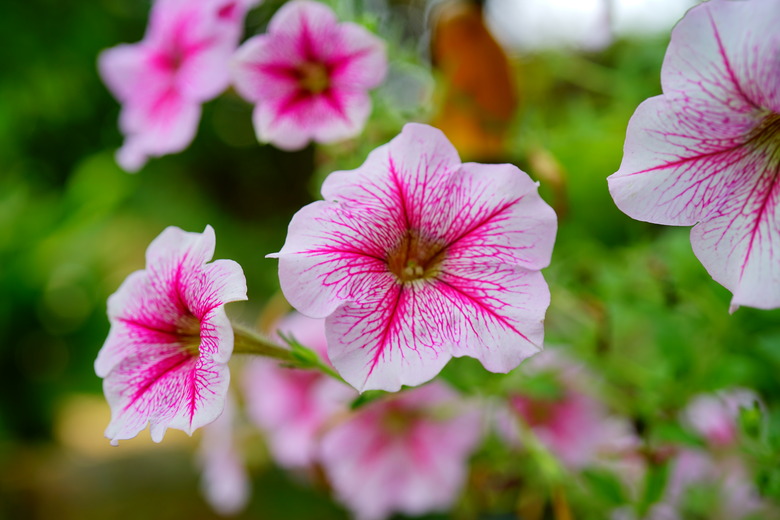What Are The Tiny White Spots On My Petunias?
Petunias (Petunia x hybrida, USDA zones 10-11) are relatively pest- and disease-free, but from time to time problems do arise, and one common complaint is tiny white spots on petunias, whether on the flowers, foliage or both. These mystery white spots could be one of a few different problems. Thrips, botrytis and fertilizer burn are common causes of white spots on petunias. If you still aren't sure, consult a specialist at your local county extension office.
Tip
A number of issues can cause tiny white spots on petunias, including thrips, fungal infections and fertilizer burn.
Thrip Insect Infestation
Thrip Insect Infestation
Thrips are tiny insects that feed on petunia flowers and foliage. They actually scrape away plant tissue and leave bleached spots or streaks where once there was bright, beautiful color. Foliage and flowers may also appear silvery or bronze due to feeding. Serious infestations may leave flowers deformed.
Thrips hide inside petunia flowers so controlling them can be difficult. Add to that the fact that they're small enough to be blown in on the wind. Organic pest control agents are best, such as neem oil, pyrethrins or insecticidal soap, because they allow beneficial insects that are natural predators to thrive. Always use any pesticide, whether it's organic or synthetic, according to all label directions.
Botrytis Blight Infection
Botrytis Blight Infection
Botrytis is a common fungal infection that attacks many ornamental and flowering plants, and petunias are no exception. The good news is that if botrytis is the cause of the tiny white spots on petunias, you've caught the disease early and have time to treat it. Eventually, those white spots turn to a gray, powdery mess that completely destroys the petunia flowers.
It's easily transmissible to other plants in the garden and thrives in wet, humid conditions. Petunias drop their flowers once they've died, and spent flowers on healthy foliage is one cause of the infection. Stay on top of petunias: deadhead the plants and clean up dead plant material. Remove infected plants and destroy them.
Powdery Mildew Disease
Powdery Mildew Disease
Powdery mildew creates powdery white spots that are sometimes fluffy. They can develop on all parts of the petunia, including the leaves, flowers and stems, often starting on the lower leaves. Later in the season, you might notice small round black spots in the white spots. The leaves might also become distorted with curling, yellowing and twisting possible effects. Powdery mildew is more likely in humid conditions.
While powdery mildew affects the look of your petunias, it often doesn't kill them. Cut out the diseased plant parts to keep it from spreading. Pruning when the plant is wet can help keep the spores from spreading to other plants. Put the removed plant material in a plastic bag and discard it to prevent spreading the disease. You can prevent it from occurring with proper plant spacing, which allows for air circulation, and by using disease-resistant petunias.
Fertilizer Burn Damage
Fertilizer Burn Damage
Another potential cause of white spots on petunias is fertilizer burn. In an effort to grow the biggest, best plants, some gardeners may over-fertilize. Too much fertilizer results in too much salt in the soil, which burns petunia roots. Inaccurate applications of dry fertilizers may end up on foliage and flowers, causing burns and white spots. Water in dry fertilizers at the time of application, and don't let them touch aboveground plant parts.
Preventive Care for White Spots
Preventive Care for White Spots
Healthy petunias have a better chance of withstanding infection and infestations than weak ones. Make sure your plants are getting enough sun, water and fertilizer to prevent white spots on petunias. Petunias prefer full sun, but in places with very hot afternoon sun, a little afternoon shade is best.
Water to a depth of 6 to 8 inches once the soil is dry. Drip irrigation or soaker hoses will direct water at the roots and keep it off the foliage where it invites botrytis and other fungal infections.
